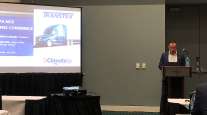Maintenance, Compliance Advantages Boost Appeal of Auxiliary Power Units

Fleets are finding that auxiliary power units offer more than the potential to reduce fuel use — they also can limit wear on newer trucks’ emissions systems and help drivers comply with anti-idling laws.
Alongside this widening appeal for APUs — which power “hotel” loads such as air conditioning and electricity while over-the-road trucks are parked and might otherwise sit with their engines idling — is also an expansion of technological innovation that promises new variations on a piece of equipment that is becoming increasingly important to trucking companies.
“Fleets recognize the impact an APU can have on reducing truck- engine maintenance,” said David Kiefer, director of sales and marketing for Carrier Transicold, a Farmington, Connecticut-based manufacturer of truck equipment such as refrigeration units and APUs. “Running an APU instead of idling the truck can reduce wear on the truck engine, [which] can translate into a reduction in maintenance and other related costs.”
Among those costs is fuel. APUs typically burn 10% to 12% of the fuel a truck’s engine would consume while idling. So even as diesel prices remain low, fleets still can reap an attractive return on investment in an APU, said Steve DeLarosby, product manager for Thermo King’s APU and heater lines.
“The [return on investment] is very dependent on fuel pricing, so now — with falling prices — it is impacting the [payback] period.” he said.
Indeed, while inexpensive diesel prices could extend ROI calculations for an APU, the savings are still worthwhile, Kiefer said.
“Diesel prices continue to make compelling financial incentives to use an APU,” he said. However, fuel prices are not the only consideration.
“Payback periods can be relatively short — less than four years, inclusive of annual maintenance costs,” he said.
And service intervals can be lengthy, typically in the range of 500 hours. In the case of Thermo King’s TriPac unit, the service interval is 2,000 hours, DeLarosby said.
But regardless of the interval, APUs still will need maintenance, which means a visit to the repair shop. However, offsetting that maintenance is a reduction in wear of emissions equipment on newer trucks, including one component that sometimes draws the ire of maintenance managers: diesel particulate filters.
“There’s a lot of dissatisfaction with clogging DPFs,” said Josh Lupu, director of marketing at Webasto, a German company with a U.S. division in Fenton, Michigan, that manufactures vehicle components. “In many maintenance facilities, it is the No. 1 or No. 2 problem.”
DPFs capture diesel-exhaust soot particles in a ceramic filter. They were introduced in 2007 to bring trucks into compliance after the Environmental Protection Agency enacted limits on exhaust particulates.
Under certain operating conditions the DPF will clean itself — a process known as “passive regeneration.” For linehaul trucks, that typically happens as the truck is driving down the road.
But if DPF cleaning is required when a truck is not moving down the road, an “active” regeneration must be conducted: Diesel fuel is injected upstream of the DPF and mixed with hot exhaust to burn excessive soot captured in the filter.
In addition to affecting fuel use, DPF regenerations add wear to the filter. The filters eventually must be replaced — at a cost of up to $7,000 — so use of an APU can help extend a filter’s service life.
Diesel APUs also have their own aftertreatment systems, optimized to the duty cycle of the secondary engine.
Individual fleets would need to crunch the numbers to see if APUs can generate sufficient returns, but the units are making a difference for Melton Truck Lines, said Jeff Robinson, senior vice president of maintenance for the carrier based in Tulsa, Oklahoma.
Melton ranks No. 90 on the Transport Topics Top 100 list of the largest U.S. and Canadian for-hire carriers.
“We run a payback analysis every year to make sure we’re on track,” Robinson said. “With that said, we factor in maintenance issues, and we find it does work for us.”
Melton’s trucks are on a four- to five-year trade cycle, he said, noting that the reductions in engine idling time afforded by the APUs — which are installed on all of the fleet’s trucks — offer savings over the lifetime of the truck. Plus, the presence of an APU can add value to trucks that are leaving Melton’s fleet, he said.
“We sell our own used trucks and see the market,” Robinson said. “Having an APU means a twofold return with fewer engine hours and a higher residual value.”
These ROI calculations soon may become more involved, as the selection of APUs that fleets such as Melton can choose from is expanding.
A key alternative to diesel-powered APUs are battery electric climate control systems, or electric APUs. These units store power in battery packs that provide power for an air conditioning compressor and evaporator-condenser setup. Using inverters, the battery packs can deliver 110- to 120-volt power.
For heat, the battery-powered units typically rely on electrically powered heat strips or a supplementary diesel-fuel heater. Webasto and Eberspaecher, formerly known as Espar, are among the suppliers of these heating units.
Alternatives to traditional air conditioners include “cool” storage units, such as the BlueCool system from Webasto. With this technology, water is frozen by a refrigeration device while a truck is running and stored as ice in a special matrix. Forced air over the melting ice can provide up to 10 hours of cab cooling.
As with the electric APUs, supplementary systems are required for heat.
Vigia-Viesa Canada offers Viesa, a product that relies on the evaporative cooling of air drawn over a water-soaked medium to provide cab cooling.
For refrigerated fleets, which often have dedicated trailer-tractor operations, Idle Free Systems offers Reefer Link, which uses the trailer refrigeration unit’s power to maintain a charge on electric APU batteries. The company also offers a “work-truck” solution for cab heat to avoid idling to maintain a comfortable cab in cold ambient temperatures. Dometic Corp., in Pompano Beach, Florida, a company long associated with climate solutions, also offers work-truck systems for heating and cooling.
One area where diesel-powered APUs have an advantage over other systems is run time. Fuel-burning units can run as long as the tank is filled, but electrical and other cooling systems are designed to offer cab cooling for about 10 hours per charge. For longer periods of downtime, including during federally mandated driver rest periods or for recharging of APUs, shore power is an option.
Shore power is a stationary application in which an external electricity supply is connected to the truck through a cable. Availability is expanding nationwide, predominantly at truck stops, thanks to efforts from companies such as Knoxville, Tennessee-based IdleAir and Shorepower Technologies, which has offices in Hillsboro, Oregon, and Utica, New York, to develop plug-in systems.
Truck parking areas around the country have more than 1,700 plug-in parking spaces, Carrier’s Kiefer said.
Shorepower is working with Cascade Sierra Solutions, of Eugene, Oregon, to install more truck-stop electrification through an initiative funded by the Department of Energy called the Shorepower Truck Electrification Project, or STEP.
Alan Bates, vice president of marketing for Shorepower Technologies, noted that the number of truck stops offering power has increased more than threefold since the beginning of 2012. “In five years, we expect 400 to 500 truck stops will be offering powering,” he said.
A recently announced alternative to shore power is vehicle-mounted solar cells for onboard electrical generation. In 2014, Victoria, British Columbia’s Go Power unveiled its Solar Flex system, which uses flexible solar panels that can generate 110- to 120-volt power with no fuel use. According to the company, the panels can be applied to the roof of the tractor or trailer.
Go Power claims Solar Flex can power relatively low-current devices directly through inverters or can charge electric APU battery packs. The thin, flexible, Solar Flex GP-Flex series panels were developed for the recreational vehicle industry, where AC power loads and HVAC climate control demands are similar to those of a small cottage, the company said. The Solar Flex panels were designed to fit the contour of an RV roof.
“By focusing on fully solar-powering RVs, we tackled and solved the hardest problem first,” said Sean O’Connor, sales channel manager for Go Power North America. “I can’t imagine a sleeper cab with a power demand that would even approach what our Solar Flex technology has been able to deliver to full-time RVers.”Cummins Crosspoint, a five-state Cummins distributor based in Indianapolis, has developed ClimaCab, a system that handles the requirements for reefer batteries and cab climate control.
Joe Aschenbener, general manager of Crosspoint Power and Refrigeration, noted that the built-in telematics in many reefer units can drain their starter battery completely within just four days of sitting idle and that the downtime and service cost of jumping a dead battery can add up.
“In the case of our ClimaCab battery-powered cab-comfort systems, it’s critical that optimal charge is maintained at all times,” Aschenbener said.
He noted that his company’s system is compatible with Solar Flex.
“The trickle charge generated by the new Solar Flex system assures us that reefer and [truck] batteries are always at the ready, regardless of the inactivity of the vehicle,” he said.
Those periods of truck inactivity are driven by more than simply driver hours-of-service rules. In some areas, laws prohibit drivers from idling their engines while trucks are parked.
Less idling of the truck engine can reduce both nitrogen oxides and particulate matter because of the lower total fuel used, while also cutting greenhouse-gas emissions.
Further, APUs that rely on shore power give drivers an easy way to take advantage of electric power sources when parked.
“Shore power capability enables a diesel APU to be plugged into an electric power receptacle, bypassing the generator and eliminating the need to run the APU engine,” Carrier Transicold’s Kiefer said.
“Truck-stop electrification through the STEP project provides environmental benefits that come from not running the truck or APU engines,” he said. “At around $1 per hour for electricity, it may also provide a cost savings in situations where drivers need to park for short rest breaks or overnight stops.”



